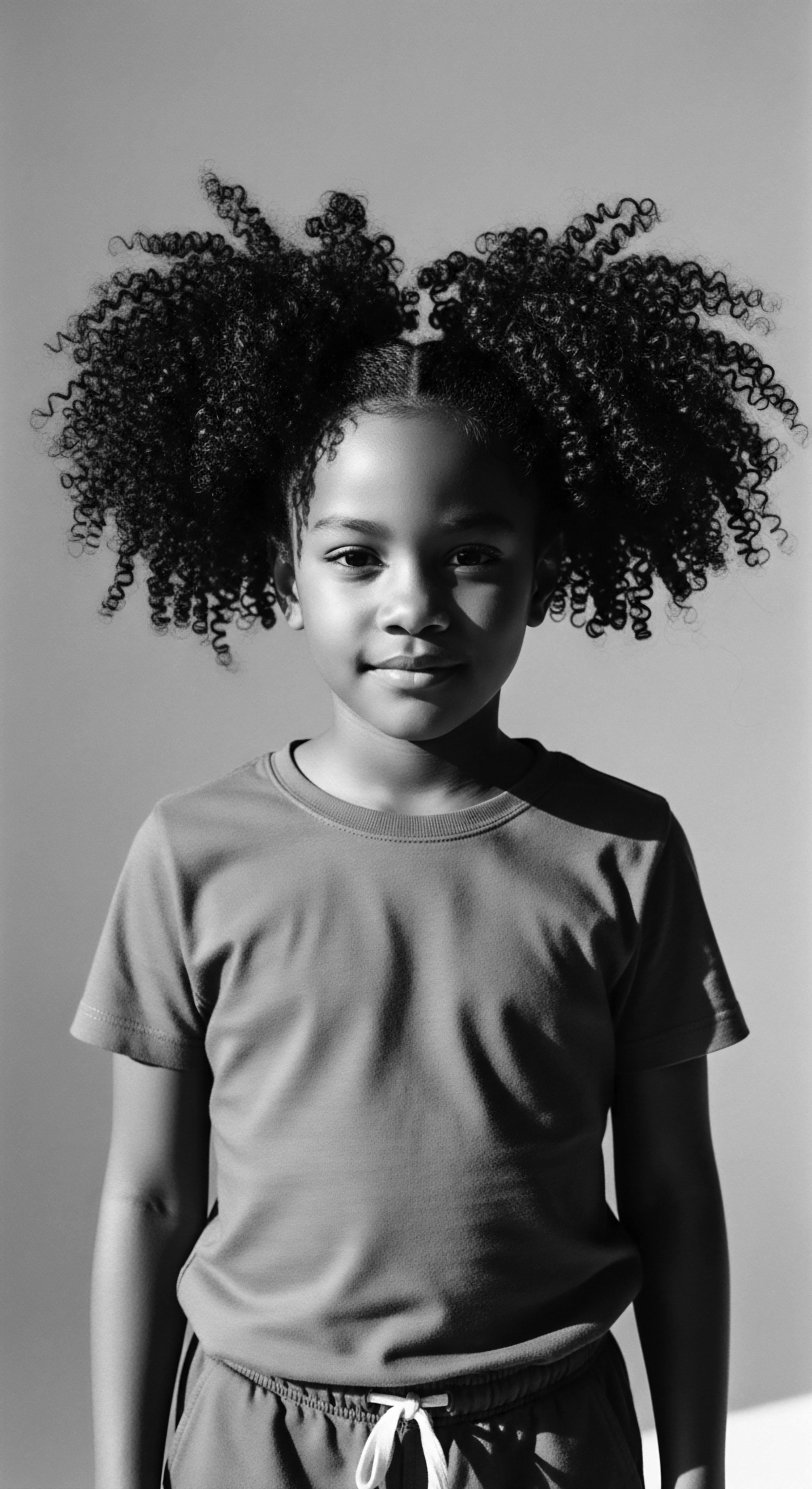
Fundamentals
Within the living library of Roothea, where each strand whispers tales of ancestry and resilience, the concept of Epigenetics Hair emerges not as a fleeting trend but as a profound echo from the very source of our being. This is not simply about the inherited curl patterns or the innate strength passed down through genetic blueprints. Instead, it speaks to a deeper, more fluid interaction ❉ the way our lived experiences, the very air we breathe, the nourishment we receive, and the stresses we encounter, can subtly, yet significantly, influence how our hair’s genetic instructions are read and expressed. It is a fundamental understanding that extends beyond the fixed code of DNA, reaching into the dynamic realm where environment and heritage dance in silent conversation.
The Delineation of Epigenetics Hair begins with appreciating that our hair follicles, these tiny, miraculous organs beneath our scalp, are not static entities. They are miniature processing centers, constantly responding to internal and external cues. While the primary structure of our hair—whether it forms tight coils, gentle waves, or straight strands—is indeed written in our inherited genes, the health, vitality, growth cycles, and even the very resilience of those strands can be modulated.
Think of it as the difference between a musical score (our DNA) and the performance of that score (our hair’s expression). The score remains the same, but the performance can vary based on the conductor, the musicians, and the very atmosphere of the concert hall.
For those new to this profound concept, understanding Epigenetics Hair involves recognizing that the hair we see and touch is a living record, a testament to generations of environmental interaction. It helps us understand why individuals with similar genetic backgrounds might experience variations in hair shedding, scalp health, or responsiveness to care. This understanding is particularly resonant for those with textured hair, whose ancestral lines have often navigated diverse climates, diets, and socio-cultural pressures, all of which leave their subtle imprints.
The Clarification here is that epigenetics does not alter the underlying DNA sequence itself, but rather controls which genes are turned “on” or “off,” or how strongly they are expressed. These modifications, like tiny flags or markers on the DNA, can sometimes be passed down through generations, creating a legacy of adaptability or vulnerability.
Epigenetics Hair represents the dynamic dialogue between our genetic inheritance and the environment, shaping how our hair’s inherent characteristics are expressed and experienced.
Consider the simplest aspects of hair biology through this lens. Hair growth, for instance, follows a cycle of anagen (growth), catagen (transition), and telogen (rest). While the duration of these phases is largely genetic, factors like chronic stress, nutritional deficiencies, or even exposure to certain chemicals can shorten the anagen phase, leading to increased shedding or slower growth. This is an epigenetic influence at play, where external factors alter the optimal functioning of the hair follicle’s genetic machinery.
The Explanation lies in modifications like DNA methylation or histone modification, which are biochemical tags that can make genes more or less accessible for reading. When genes responsible for healthy hair growth are less accessible due to environmental stressors, the hair’s vitality can wane.
The initial step in comprehending Epigenetics Hair, therefore, is to shift our perspective from a purely deterministic view of genetics to one that embraces the fluid, responsive nature of our biological heritage. It is about recognizing that the choices we make, the environments we inhabit, and the ancestral wisdom we carry forward, all contribute to the story our hair tells. This fundamental Statement grounds us in the power of conscious care and a deep respect for the legacy within each strand.

Intermediate
Moving beyond the foundational tenets, the intermediate understanding of Epigenetics Hair invites us to delve deeper into the mechanisms and implications that hold particular resonance for textured hair heritage. Here, the Meaning of Epigenetics Hair expands to encompass the profound ways in which ancestral experiences, cultural practices, and environmental pressures have sculpted the very responsiveness of our hair follicles across generations. It is not merely about individual variations but about the collective biological memory held within our hair.
For textured hair, often originating from lineages that have endured significant environmental shifts and historical traumas, the epigenetic lens offers a compelling perspective. Consider the historical journey of Black and mixed-race communities ❉ forced migrations, radical dietary changes, chronic stress from systemic oppression, and exposure to vastly different climates. Each of these elements, while not directly altering the fundamental curl pattern, could have subtly influenced the expression of genes governing scalp health, moisture retention, protein synthesis within the hair shaft, and even the hair’s inherent resilience against breakage. The hair, in this context, becomes a living archive, a record of adaptive responses and persistent challenges.
One compelling historical example that sheds light on this intergenerational impact, though not always framed explicitly in epigenetic terms by its original chroniclers, concerns the severe nutritional deficiencies and extreme stress experienced by enslaved Africans during the transatlantic slave trade and subsequent periods of forced labor. As documented by scholars such as Ayana Byrd and Lori Tharps in their comprehensive work, Hair Story ❉ Untangling the Roots of Black Hair in America (2001), the diets of enslaved individuals were often woefully inadequate, lacking essential vitamins, minerals, and proteins crucial for healthy hair growth. This pervasive malnutrition, combined with relentless physical labor, exposure to harsh elements, and immense psychological trauma, undoubtedly impacted the physiological state of their hair and scalp. Hair became brittle, dry, prone to breakage, and sometimes experienced significant thinning or loss.
The historical context of textured hair reveals how generations of environmental stressors, like nutritional deficiency and chronic stress, have shaped hair’s biological expression and cultural care practices.
In response to these profound environmental pressures, ancestral care practices evolved not just as cosmetic routines, but as vital acts of self-preservation and community bonding. Ingredients like natural oils (e.g. shea butter, coconut oil, castor oil), herbs, and specific cleansing rituals, passed down through oral traditions, were employed to nourish, protect, and restore hair vitality. While these practices were pragmatic responses to immediate needs, from an epigenetic standpoint, they represent a powerful form of environmental modulation.
By providing external nourishment and protection, these practices aimed to mitigate the negative expressions of genes that might have been downregulated due to severe stress and malnutrition. The consistent application of these traditional methods, generation after generation, could be seen as an ongoing dialogue with the hair’s inherent biology, supporting its optimal function despite challenging circumstances.
The Specification of Epigenetics Hair at this level recognizes specific epigenetic mechanisms. For instance, DNA methylation, where methyl groups attach to DNA, can silence genes. If genes responsible for robust keratin production or healthy sebaceous gland function were hypermethylated due to chronic stress or inflammation, hair could become weaker or drier. Conversely, histone modifications, which affect how DNA is wrapped around proteins, can make genes more accessible.
A nutrient-rich environment or stress-reducing practices might support histone modifications that promote the expression of genes for hair strength and elasticity. This suggests a continuous interplay between ancestral environments, dietary patterns, stress responses, and the molecular switches that dictate hair’s appearance and health.
The understanding here is not that textured hair itself is an epigenetic phenomenon, but rather that the health, growth, and specific responses of textured hair are profoundly influenced by epigenetic marks accumulated and transmitted over time. This offers a lens through which to appreciate the resilience of textured hair and the wisdom embedded in traditional care practices. It highlights that care is not just about what we apply externally, but about how we nurture the very biological systems that govern our hair’s expression, honoring the legacy of those who came before us.
Consider the following examples of how traditional wisdom might align with epigenetic principles ❉
- Herbal Infusions ❉ Many ancestral hair rinses and masks utilized herbs known for their anti-inflammatory or nourishing properties. These compounds, rich in antioxidants and vitamins, could help mitigate oxidative stress at the follicle level, potentially influencing gene expression related to hair follicle health and longevity.
- Scalp Massages ❉ Regular scalp stimulation, a common practice in many hair traditions, improves blood circulation to the follicles. Enhanced blood flow delivers essential nutrients and oxygen, supporting optimal cellular function and potentially influencing the epigenetic landscape to favor healthy hair growth.
- Protective Styling ❉ Styles that minimize manipulation and exposure to harsh elements, like braids and twists, have been a cornerstone of textured hair care for centuries. This protection reduces physical stress on the hair and scalp, creating an environment where follicles can thrive without constant mechanical insult, thus supporting their optimal genetic expression.
The enduring Significance of Epigenetics Hair for textured hair heritage lies in its capacity to validate the deep wisdom of ancestral care. It provides a scientific framework for understanding why certain practices, honed over centuries of lived experience, were so effective in maintaining hair health and vitality despite challenging circumstances. This perspective encourages us to look beyond superficial treatments and connect with the deeper biological and historical currents that shape our hair.

Academic
The academic Definition of Epigenetics Hair posits a sophisticated understanding of how supra-genomic factors influence the phenotypical expression of hair characteristics, moving beyond the deterministic confines of Mendelian inheritance. It describes the study of heritable changes in gene expression that do not involve alterations to the underlying DNA sequence itself, but rather modifications to the chromatin structure or DNA packaging that dictate gene accessibility and activity within the hair follicle. For the scholar of textured hair heritage, this concept transcends mere biology, becoming a powerful lens through which to analyze the interplay of ancestral environmental pressures, socio-cultural adaptive practices, and the biological resilience embedded within the hair shaft across generations.
At its most rigorous, Epigenetics Hair involves the examination of specific molecular mechanisms such as DNA methylation, histone modification, and non-coding RNA regulation within the dermal papilla cells, outer root sheath cells, and other follicular components. These epigenetic marks act as regulatory switches, influencing the transcription of genes critical for hair cycle regulation, keratinocyte differentiation, melanin synthesis, and the structural integrity of the hair fiber. For instance, altered methylation patterns in genes associated with hair follicle stem cell maintenance could lead to premature telogen entry or follicular miniaturization, phenomena often observed in various forms of alopecia. The Elucidation of these mechanisms offers a profound insight into why individuals with similar genetic predispositions for textured hair might exhibit variations in hair density, growth rate, or susceptibility to environmental stressors.
A particularly compelling academic angle, deeply rooted in cultural and historical understanding, involves the concept of Allostatic Load and its potential epigenetic consequences for textured hair. Allostatic load refers to the cumulative wear and tear on the body’s systems due to chronic stress. For communities of the Black diaspora, generations have navigated systemic racism, economic hardship, and cultural assimilation pressures, creating a persistent state of physiological vigilance. Research in psychoneuroimmunology has demonstrated that chronic stress can induce widespread epigenetic modifications, particularly through altered cortisol signaling pathways, which in turn can influence inflammatory responses and cellular regeneration.
Academic inquiry into Epigenetics Hair reveals how chronic stress and environmental adaptation, particularly within diasporic communities, can induce heritable epigenetic modifications affecting hair vitality and resilience.
While direct, longitudinal studies specifically linking allostatic load to epigenetic changes in hair follicles across multiple generations of Black individuals are still emerging and complex to execute, the theoretical framework suggests a powerful connection. For example, prolonged exposure to stress hormones could lead to epigenetic silencing of genes responsible for antioxidant defense within the hair follicle, rendering it more vulnerable to oxidative damage. Similarly, nutritional disparities, a persistent challenge for many marginalized communities, can directly impact the availability of methyl donors and other cofactors essential for proper epigenetic programming, potentially affecting hair growth and structural protein synthesis. This Interpretation moves beyond simple deficiency to consider the systemic impact on gene regulation.
Consider the case of the impact of chronic inflammation on hair follicles , a condition often exacerbated by stress and certain dietary patterns prevalent in communities facing socio-economic disparities. Chronic low-grade inflammation can trigger pro-inflammatory cytokines that epigenetically alter the cellular microenvironment of the hair follicle, potentially leading to premature catagen induction or impaired anagen growth. This is not merely about hair loss but about the sustained health and vigor of the follicle itself, reflecting generations of environmental engagement. The academic rigor here demands that we consider the broader social determinants of health as epigenetic modifiers, acknowledging that historical injustices can leave biological imprints that affect hair’s biological narrative.
The academic Meaning of Epigenetics Hair also extends to the intergenerational transmission of adaptive knowledge within textured hair care traditions. While not a direct epigenetic modification of the hair follicle itself, the consistent application of specific ingredients or practices—such as deep conditioning with nutrient-rich oils, scalp massages, or protective styling—can be viewed as a form of cultural epigenetics. These practices, honed over centuries, created an external environment that actively supported the optimal expression of hair genes, effectively buffering against negative environmental pressures.
This cultural transmission of care knowledge, passed down through matriarchal lines, serves as a powerful testament to collective resilience and biological wisdom. The Designation of these practices as ‘cultural epigenetics’ highlights their role in shaping the lived biological reality of textured hair, influencing its health and appearance over generations.
The academic inquiry into Epigenetics Hair necessitates a multidisciplinary approach, drawing from molecular biology, dermatology, anthropology, history, and public health. It challenges us to move beyond a simplistic understanding of genetics and embrace the profound complexity of how our biological inheritance is continuously rewritten by our environment and lived experience. The implications are far-reaching, suggesting that interventions aimed at improving hair health, particularly for textured hair, must consider not only individual genetic predispositions but also the epigenetic legacy of ancestral environments and the potential for positive epigenetic reprogramming through holistic care and reduced systemic stressors. This approach validates the historical struggle and resilience of Black and mixed-race communities, recognizing their hair not just as a physiological entity but as a profound marker of their enduring journey.
| Environmental Factor (Historical/Ancestral) Nutritional Scarcity (e.g. forced diets during slavery) |
| Potential Epigenetic Influence on Hair Altered gene expression for keratin synthesis, impaired hair growth cycle, reduced hair strength. |
| Adaptive Cultural Hair Practice (Ancestral Wisdom) Oil Treatments (e.g. shea butter, castor oil) to lubricate, protect, and provide external nourishment. |
| Environmental Factor (Historical/Ancestral) Chronic Stress & Trauma (e.g. systemic oppression, migration) |
| Potential Epigenetic Influence on Hair Dysregulated stress hormone pathways, increased inflammation, potential silencing of protective genes in follicles. |
| Adaptive Cultural Hair Practice (Ancestral Wisdom) Scalp Massages & Herbal Rinses for circulation, calming, and topical anti-inflammatory benefits. |
| Environmental Factor (Historical/Ancestral) Harsh Climates & Labor (e.g. sun exposure, physical abrasion) |
| Potential Epigenetic Influence on Hair Increased oxidative damage, reduced moisture retention, cuticle degradation. |
| Adaptive Cultural Hair Practice (Ancestral Wisdom) Protective Styling (e.g. braids, wraps) to shield hair from environmental aggressors. |
| Environmental Factor (Historical/Ancestral) Limited Access to Clean Water/Hygiene |
| Potential Epigenetic Influence on Hair Increased scalp infections, fungal growth, impaired follicular health. |
| Adaptive Cultural Hair Practice (Ancestral Wisdom) Clay Washes & Natural Cleansers for gentle, purifying scalp detoxification. |
| Environmental Factor (Historical/Ancestral) These intergenerational factors and adaptive practices underscore the deep connection between textured hair's biological expression and its rich historical heritage. |
The academic discussion of Epigenetics Hair thus becomes a testament to the profound connection between biological expression and the lived experiences of a people. It urges us to view hair not as a mere aesthetic feature but as a dynamic biological canvas, continuously shaped by the echoes of the past and the realities of the present. This holistic understanding validates the historical resilience of textured hair and the enduring wisdom embedded in ancestral care traditions, offering a robust framework for future research and culturally informed wellness practices.

Reflection on the Heritage of Epigenetics Hair
As we draw our exploration of Epigenetics Hair to a close, a quiet reverence settles, a deep appreciation for the living narrative held within each strand. This concept, far from being a mere scientific abstraction, stands as a profound meditation on the enduring heritage of textured hair, its boundless resilience, and the ancestral wisdom that has guided its care through the ages. It is a concept that truly embodies the ‘Soul of a Strand’ ethos, for it acknowledges that our hair is not simply a biological inheritance but a dynamic chronicle of our collective journey, written in the very expression of our genes.
The hair we tend today carries whispers of ancient winds, the warmth of ancestral hands, and the echoes of environments both challenging and nurturing. The coils, kinks, and waves that define textured hair are more than just genetic markers; they are a testament to adaptability, to survival, and to the continuous dialogue between our internal biological landscapes and the external world. Understanding Epigenetics Hair allows us to see this dialogue with renewed clarity, recognizing that the health and vitality of our hair are deeply intertwined with the stories of our forebears. It grants us a perspective that validates traditional practices, revealing how seemingly simple rituals – a specific oil, a gentle detangling, a protective style – were, in essence, sophisticated acts of biological and cultural preservation.
This understanding calls upon us to approach hair care not as a superficial routine but as a sacred practice, a continuation of a legacy. It encourages us to listen to our hair, to observe its responses, and to honor the wisdom that has been passed down through generations. When we choose to nourish our hair with natural ingredients, when we protect it from undue stress, when we celebrate its unique form, we are not just caring for ourselves; we are participating in an unbroken lineage of care. We are affirming the profound connection between our present selves and the ancestral past, allowing the biological memory of resilience to continue to unfold.
The heritage of Epigenetics Hair is a powerful reminder that our bodies, including our hair, are not isolated entities but rather living, breathing archives. They carry the imprints of historical experiences, adapting and expressing themselves in ways that reflect the journey of our people. For textured hair, this means recognizing its strength in the face of adversity, its capacity for vibrant expression, and its deep connection to identity and community. It is a call to cherish this unique heritage, to understand its scientific underpinnings, and to continue to write its story with reverence and conscious intention, ensuring that the soul of each strand continues to resonate for generations to come.

References
- Byrd, A. & Tharps, L. (2001). Hair Story ❉ Untangling the Roots of Black Hair in America. St. Martin’s Press.
- Griffiths, P. (2014). Genetics and Philosophy ❉ An Introduction. Cambridge University Press.
- Holliday, R. (2006). The Epigenetics of Human Disease. Academic Press.
- Jirtle, R. L. & Skinner, M. K. (2007). Environmental Epigenomics and Disease Prevention. Elsevier.
- Landecker, H. (2013). Cultivating Difference ❉ The Epigenetics of Human Development. University of Chicago Press.
- Lock, M. & Nguyen, V. K. (2010). An Anthropology of Biomedicine. Wiley-Blackwell.
- Sapolsky, R. M. (2004). Why Zebras Don’t Get Ulcers. Henry Holt and Company.
- Schick, K. & Schick, M. (2013). The Archaeology of Human Hair. University of California Press.
- Skinner, M. K. (2015). Environmental Epigenetics. Academic Press.
